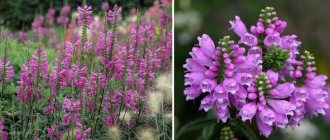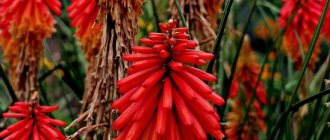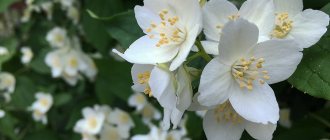Scabiosa is a flowering plant from the teasel subfamily, honeysuckle family. Popular names of the crop: “navel”, “shishkornik”, “cornflower”, “tease”, “needlecushion”. In nature, scabiosis can be found in different climatic zones of Europe and Asia. It is a shrub that can reach a height of 1 m. The leaves are dissected or lanceolate. Inflorescences can be of various shapes and colors, depending on the species.
Scabiosa is effectively used for growing in flower beds and garden plots. She is unpretentious and feels good in temperate latitudes. Thanks to its varietal diversity, this flower often becomes an integral part of the landscape.
Types and varieties for open ground
There are about 100 varieties of scabiosa. Most of them are obtained through selection. Among them there are both annuals and perennials. The types of scabiosa described below are most often cultivated in open ground.
Star-shaped
An annual native to Southern Europe, 15-45 cm high. The flowers are pale blue, collected in capitate inflorescences, located on long peduncles.
Dark purple
An annual species with branched straight stems, reaching a height of 1-1.2 m. It is also called widow's flower and Egyptian rose. Dark purple, white or pink flowers bloom on long, flexible stalks (depending on the variety).
Caucasian
Perennial 0.7-0.9 m high. The stems are strong and lightly branched. The leaves are lanceolate and form a basal rosette. The flowers are collected in capitate inflorescences up to 10 cm in diameter. They can be white, pink, or blue. The crop blooms in June-July.
Venechnaya
Low perennial up to 0.5 m tall. Stems are erect, with few branches. The stem leaves are on short petioles, pinnately divided. Flowers up to 3 cm in diameter are light bluish.
Japanese
A low perennial species up to 25 cm high, which is found mainly in the mountains. The plant bushes well and blooms for a long time. The flowers are mostly lilac.
Pale yellow
Tall herbaceous hybrid with feathery leaf blades. The flowers are pale yellow.
Description of the plant
Scabiosa is a species belonging to the Honeysuckle family (Caprifoliaceae). These plants are found in Europe and Western Asia (as far as Siberia, the Caucasus), in the mountains of Eastern and Southern Africa. Representatives of the genus Scabiosa usually grow in meadows, clearings, rocky places, and woodlands. Flowers are pollinated by bees, butterflies, and flies.
Some species are grown as ornamental plants and used for medicinal purposes. Crushed pigeon scabiosa roots are used as a skin powder.
Botanical description:
- Form. Annual, biennial or perennial plants, less often subshrubs and low shrubs. Reaches a height of 1 m.
- The leaves are alternate, the lower ones are usually entire, serrated or pinnate, the upper ones are pinnate.
- Scabiosa flowers are collected in flat baskets or spherical heads (the bottom of the inflorescence is bare, convex or hemispherical), supported by soft integumentary leaves with an awl-shaped end. The marginal flowers are larger than those inside the inflorescence. The color of flowers of different species varies - white, yellow, pink, purple, blue. The calyx is fused at the bottom, with 5 setae at the apex. Crown with 5 spots at the end. Four stamens. Flowers located on the periphery develop first and gradually bloom towards the center.
- The fruits are achenes with 5 awns.
Among the dozens of known varieties, only a few are grown in gardens. Let's study the most popular species, their requirements for cultivation and use in gardens.
Growing from seeds to seedlings
Scabiosa can be grown in different ways. The most commonly used is seed. You can sow seeds directly into the ground or onto seedlings. In temperate climates, it is preferable to grow the flower in seedlings. The best time to sow seeds for seedlings is the end of March and the beginning of April.
Soil and container
Prepare a low container. Fill it with universal primer mixed with sand (2:1). Disinfect it by steaming in a water bath or using a solution of potassium permanganate. Lightly compact and level the soil. Make furrows, sow the seeds to a depth of 0.5 cm. Spray the crops with a spray bottle. Cover the top of the container with film or glass. Place in a bright place at a temperature of +20..22°C.
Seedling care
Shoots may appear after 1-3 weeks, depending on the type of scabiosis. The cover must be removed daily for ventilation and removal of condensation. When sprouts appear, it can be removed. Make sure the soil is moist, but do not make it waterlogged. Light for seedlings needs to be bright, but diffused.
After the formation of 2-3 true leaves, the seedlings are planted in individual pots. After this, the seedlings need to begin to harden. She is taken outside first for 1 hour. Gradually the hardening time is increased.
Transplanting
Seedlings are planted on the site in late May - early June. Before planting, it is recommended to fertilize the soil with rotted manure. Prepare holes of such depth that the seedlings fit in them along with the earthen ball. The optimal distance between plants is 20-25 cm. Carefully remove the seedlings from the pots so as not to damage the roots. Place in the hole, press down lightly and sprinkle with soil.
Seed cultivation
Obtaining using seeds occurs through one of two ways:
- Growing seedlings;
- Sowing seeds in the ground.
The choice of one method or another depends on the region.
If severe frosts recede quite early, then you can choose the second method. Planting takes place in early April. Sowing is not done too deep, the distance is maintained. Sufficient soil moisture plays an important role, so do not forget about watering and moistening it. Next comes an additional coating with compost. There is no need to worry about the plant freezing; scabiosa is resistant to minor frosts. When propagating using this method, you can expect the first sunrises in about a couple of weeks . Now that the plants have grown stronger and grown, begin thinning, keeping a distance of more than 20 centimeters.
Scabiosa Japonica 'Blue note'
In a cold spring, you should choose the seedling method. To begin with, select a suitable container with soil in which the seeds are sown. Sowing period: late winter or early spring. After planting the seeds, the container must be closed with a glass lid or polyethylene, then placed in a room with a temperature of at least fifteen degrees. Responsible watering and ventilation of sprouts is required. When the first shoots appear, the protective coating is removed. As soon as the first leaves become visible, it is recommended to replant. Even if you choose one container for all plants, the distance between flowers should not be less than 5 centimeters. Hardening off the plant is an important step that is recommended. For example, you can “walk” the plant every day for an hour and a half, gradually increasing the time.
Scabiosa caucasica 'Stäfa'
Planting seeds in open ground
If the climate allows, spring is early and warm, you don’t have to waste time growing seedlings and sow seeds directly in the flower garden. It is better to do this in mid-April if there is no risk of night frosts.
Choice of location and lighting
Scabiosa can only grow well in light areas. Therefore, you need to choose a sunny place for sowing. It must be protected from strong winds. It is better that the site is elevated without nearby groundwater. Scabiosa does not like marshy soil. Therefore, it must be well equipped with a drainage system. This especially applies to perennials.
Landing rules
In order for scabiosa to grow well and bloom profusely, you need to prepare fertile, loose soil before sowing. It should be neutral acidity. In acidic soils the plant may die. It is recommended to dig up the area in the fall. 2 weeks before sowing, the area must be cleared of weeds and the soil loosened. Make shallow furrows at intervals of 35-40 cm and water. Place the seeds, keeping a distance of 5 cm between them. Sprinkle with soil. When the seedlings grow, they need to be thinned out, leaving the strongest specimens with intervals of 30 cm between each.
Recommended varieties
Blue butterfly
A flower with a striking blue hue, 30 to 40 cm high.
Perfecta
It has large, violet-blue flowers and dark foliage, about 60-80 cm.
Ping pong
Golden yellow flowers, also suitable as dry interior decoration.
Scabiosa japonica
Perennial. It blooms from May to August with flat, densely filled blue or pink flowers.
Caucasian (Scabiosa caucasica)
Perennial. Height from 60 to 90 cm. Blooms from June to September with large cup-shaped flowers on densely standing stems. It has branched flower stems that are blue, blue-violet or white. The petals are slightly curled. The leaves are oblong, gray-green.
Can also be sown in early spring. It is a rather difficult plant to grow, as it does not tolerate frost or dampness. Goes well with aster, rose, sage, yarrow. Take cuttings from late spring to early summer or divide the rhizome in March-April for propagation.
Nutrient-rich, permeable and calcareous soil, rather dry. Must be protected from rain. Very sensitive to frost, so good winter protection is absolutely essential. Store in a warm place in pots. Originally from the Caucasus.
Velvet (Scabiosa atropurpurea)
Annual plant. Height 40-60 cm, width 15-25 cm. Blooms from spring to late summer. It has single white, blue or purple flowers up to 5 centimeters in diameter. Green leaves. Upright dense and well branched growth. Width from 15 to 25 cm Neutral or slightly alkaline soil, which should not be too nutritious.
"Clive Greaves"
A selection of seedlings originally grown by gardener James House, who ran a successful nursery near Bristol. House's family had previously christened the white uniform "Miss Willmott" after Ellen Willmott, who worked in the garden at Worley Place in Essex. They also developed their own seed variety, commonly known as Hausa hybrids, which are still available.
'Clive Greaves', released in 1929, outperformed the rest with its robust constitution and free flowering, and has never been improved upon. The real Clive Greaves was a young tradesman who worked at Hewitt's nursery in Solihull.
All varieties are very attractive to bees and butterflies.
Scabiosa columbaria
Our summer-blooming native, Scabiosa columbaria, is a compact plant with filigree foliage and wavy stems topped with tiny blue flowers.
But perhaps the best of all the small-flowered scabiosas is the sterile hybrid 'Butterfly Blue', which is sometimes mistakenly sold as 'Irish Perpetual'. It will bloom continuously from June until late autumn. This top-notch perennial is often sold in bright pink pots, which isn't exactly inspiring for the serious gardener.
Scabiosa plants also do not like hot and humid weather. Regardless of planting type, these flowers grow best in full sun and require well-draining, organic-rich soil. Adding compost, well-rotted manure or peat moss will help enrich the soil.
Flowers are usually grown from seed, although plants grown in containers may also be available. They can be started from seed indoors in early spring or sown directly into the garden after the threat of frost has passed. The seeds germinate within two weeks and can be individually grown in pots and transplanted into the garden by May.
Outdoor care
After planting, caring for the plant on the site does not require complex manipulations. Scabiosa is absolutely unpretentious and can tolerate drought and cold weather.
Watering
The flower requires moderate watering. The soil does not need to remain wet all the time. It is enough to water the bush once a week if there is no rain. But if the weather is hot, dry, then it is doubled. After watering, the soil should be loosened.
Feeding and fertilizer
During the growing season, scabiosis needs regular feeding 2 times a month. You can take any universal mixtures for ornamental crops. Organic matter can be added only before planting. At the flowering stage, potassium-phosphorus fertilizers are applied weekly.
Care during and after flowering
The flowering time of scabiosa may vary depending on the variety.
As a rule, this is July-August. The flowers are collected in capitate inflorescences, which are formed on long peduncles. Their color can be varied. Advice! Dried buds must be removed. This prolongs the flowering of the crop and prevents self-seeding.
Trimming
In order for the scabiosa to remain attractive until late autumn, it needs to be pinched periodically. This stimulates the growth of young side shoots and improves bushiness. All dried branches and flowers should be cut out immediately. At the end of autumn, the stems of perennial species are cut off completely.
Loosening the soil
The soil under the bush needs to be regularly loosened and weeded. This is necessary for better penetration of oxygen to the roots, scabiosis will grow better.
Growing conditions – position, soil
Growing scabiosa is not difficult. The condition for trouble-free cultivation of scabiose is the permeability of the substrate and the presence of sunlight. Although some varieties, such as Chile Black, develop well in sunny and slightly shaded areas.
The soil for scabiosa should be:
- loose,
- permeable,
- slightly damp
- moderately fertile,
- with an inert or slightly alkaline pH (calcareous soils).
Scabiosa does not tolerate soil:
- heavy,
- wet,
- too dry
- quickly drying sandy.
If the soil in the garden is heavy, the plant will not survive a wet winter. It does not like winter waterlogging and disappears. Cold, wet summers are unfavorable for it.
It is not advisable to plant plants in areas with very fertile soil. Planted in very good soils, they will be taller, with flaccid shoots that will tend to lodge after rainfall. Taller varieties, such as Black Night, will require the use of supports.
Scabiosa is frost-resistant, so it does not require shelter for the winter. The exception is Japanese scabiosa.
Protection from pests and diseases
The flower is quite resistant to most diseases and pests. The plant only tolerates excess moisture with difficulty. Due to waterlogging of the soil, fungal infections (powdery mildew, root rot) can develop. If the plant begins to wither, you need to pay attention to the humidity. At the initial stage of the disease, you can treat the bush with a product containing sulfur. But if the rot has seriously affected the scabiosa, then it is better to dig it up and burn it, and disinfect the area.
Among the pests, the flower can be affected by aphids and garden slugs. To prevent their appearance, it is necessary to mulch the soil around the bush and treat it with a weak saline solution.
Scabiosa care
Since scabiosa is unpretentious, its care is minimal, although there are still a few nuances:
- Watering should be infrequent, in moderate quantities - it is better to “not top up” than to “overfill”. The signal for hydration will be a well-dried top layer of soil;
- Loosening the soil should be regular to ensure access of air to the soil. At the same time, weeds are pulled out;
- Fertilizing can be carried out throughout the entire flowering period. This will help increase the size and brightness of the inflorescences. Scabiosa “loves” potassium and phosphorus, so potassium salt and superphosphate are used for feeding;
Fertilizers for scabiosa
Trimming faded blossoms stimulates the growth of new ones.
Diseases and pests
Scabiosa is considered a crop resistant to harmful microorganisms. But violation of agricultural technology can upset the balance of the plant’s microcosm, as a result of which it may die. Known enemies of scabiosa are:
Table 2. Scabiosa pests
| Pest | Description |
| Powdery mildew | This is a fungus that develops intensively in conditions of high humidity 60-80% and at low temperatures - up to 20°C. It looks like a white coating on the leaves that quickly spreads throughout the plant. To prevent scabiosis, spray it with whey, wood ash solution or iodine solution. In advanced cases, fungicides will come to the rescue. |
| Root rot | Known as Blackleg, it is a fungal disease in which the root and part of the stem turn black and then rot, causing the death of the entire plant. The fungus forms under conditions of excessive moisture, possibly in poorly sterilized soil. As a preventative measure, moderate watering and reasonable application of fertilizers to the soil are recommended. For treatment - a fungicide, for example, Bordeaux mixture. |
| Mealybug | Or the felt louse, popularly known as the “shaggy louse” - a pest that sucks the cell sap of plants. Its activity leads to a slowdown in the growth of the crop and subsequently to its complete death. The life process of the pest is accompanied by the release of honeydew - a favorable environment for the development of the fungus. It is better to combat it immediately with insecticides, such as Admiral, Inta-vir, Aktara, etc. |
Scabiosa is a beautiful plant and there are usually no problems with growing it. Its simple flowering will delight you for many years, both in individual compositions and among variegated flower beds.
Reproduction
For annual species, only seed propagation is used. Perennials can also be propagated vegetatively - by dividing the bush and cuttings. Dig up a bush that is at least 3 years old. Remove soil from roots. Using a sharp and disinfected instrument, cut the bush into several parts. Each one should have at least 2 shoots, and there should also be strong roots. Prepare the area in advance. Dig holes of suitable size. Plant cuttings in them and water well. The procedure is best carried out in early spring or autumn. Dividing the bush allows you to rejuvenate scabiosis and stimulate its growth.
Before flowering begins, the plant can be propagated using cuttings. Using a sharp knife, cut off the young root shoot with a piece of root. Plant it in a container with loose substrate. Water the cutting regularly until it takes root. When young leaves appear, the plant can be planted on the site.
Scabiosa in floristry
Scabiosa in a bouquet of flowers photo
Read also: How to make mead without boiling
Scabiosa inflorescences are also used to create incredibly beautiful, festive bouquets. After cutting, they remain decorative for 5-7 days.
In addition, scabiosa flowers are used as dried flowers, which are a very original interior decoration.
Autumn care, seed collection and wintering
Annual species of scabiosa are dug up and thrown away in the fall. If necessary, seeds are collected at the end of summer. Select suitable inflorescences and tie them with gauze to prevent self-seeding. When the seed pods are completely dry, they are cut off. The seeds are poured out of the boxes and stored in paper bags in a dry place.
Perennials are left to overwinter on the site. After flowering has finished and the leaves have dried, the stems are cut to soil level. Scabiosa can remain without shelter. But hybrid varieties can freeze. Therefore, for the winter they are covered with dry leaves or straw. In spring the cover is removed.
When does scabiosa bloom?
What does scabiosa look like? Pictured is the variety Butterfly blue
The flowering period of scabiosa begins in July and lasts until the end of September.
The calyx is double: the outer part consists of 8 ribs, the margin is dry, the inner part is saucer-shaped, five-membered, long stamens with anthers effectively decorate the core. The color can be blue, snow-white, dark blue, pink, pale yellow, bright crimson, dark purple. The flowers are fragrant, attract bees with their nectar, and colorful butterflies flutter over them. At the end of flowering, the achene fruit ripens, filled with many small seeds of a light brown hue. 1 g of weight contains about 350 seeds.
In the natural environment, scabiosa can be found throughout the Old World; it prefers calcareous areas.
Scabiosa in landscape design
Scabiosa is used to design ridges, mixed borders, alpine slides, and mixed plantings in flower beds. Low-growing varieties decorate sidewalk paths.
Delicate pastel scabiosa flowers go well with:
- phlox;
- irises;
- peonies;
- gypsophila;
- sage;
- asters.
Floral compositions are complemented with herbs, cereals, and stones. Scabiosa is often planted for cutting. Flowers can remain fresh for 5-7 days. Therefore, they are often included in holiday bouquets.
Scabiosa is one of the most popular flowers for growing outdoors. It is drought-resistant, winter-hardy, and easy to care for. The flower is also widely used in landscape design.
Below is a video, after watching which you can find out more useful information about planting and growing Scabiosa on the site:
Fertilizer and feeding of scabiosa
The cultivation of scabiosis must be accompanied by the application of various fertilizers. This is done when the root system of the plant is already fully developed. Most often, water-soluble liquid fertilizers are used. These perennial plants are fed at the rate of 20 g of fertilizer per 1 sq. m.
Scabiosis needs to be fed several times a season.
Scabioses respond well to fertilizing in the form of phosphorus-potassium fertilizers. This helps to increase the size of the buds and their brighter, more saturated flowering.











